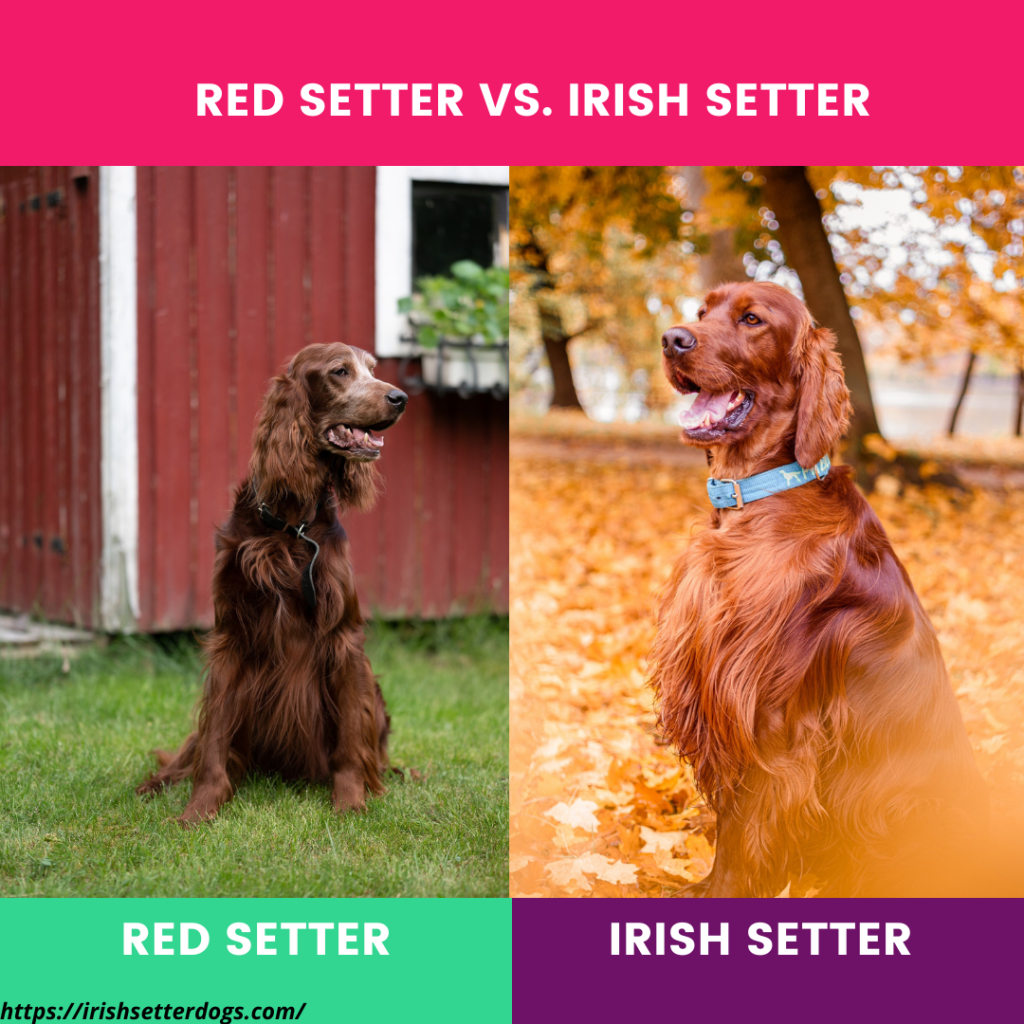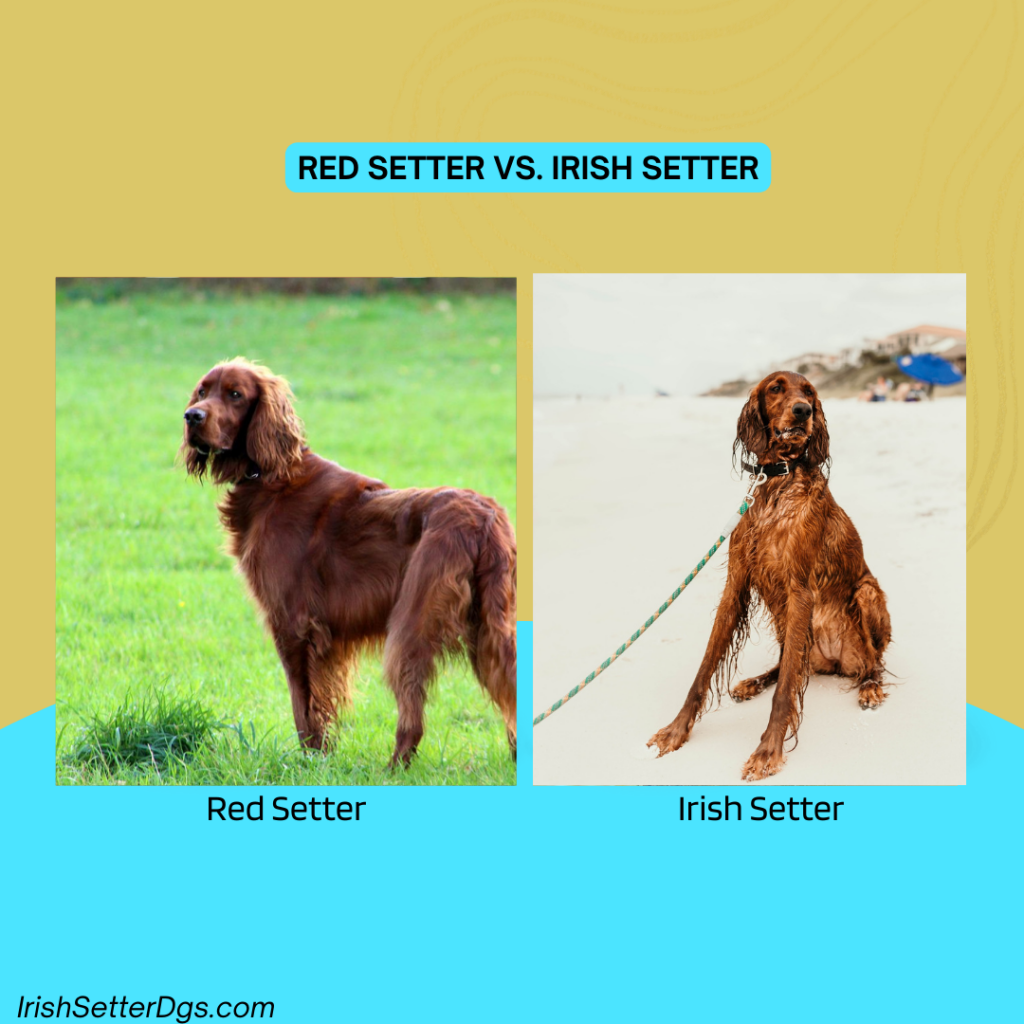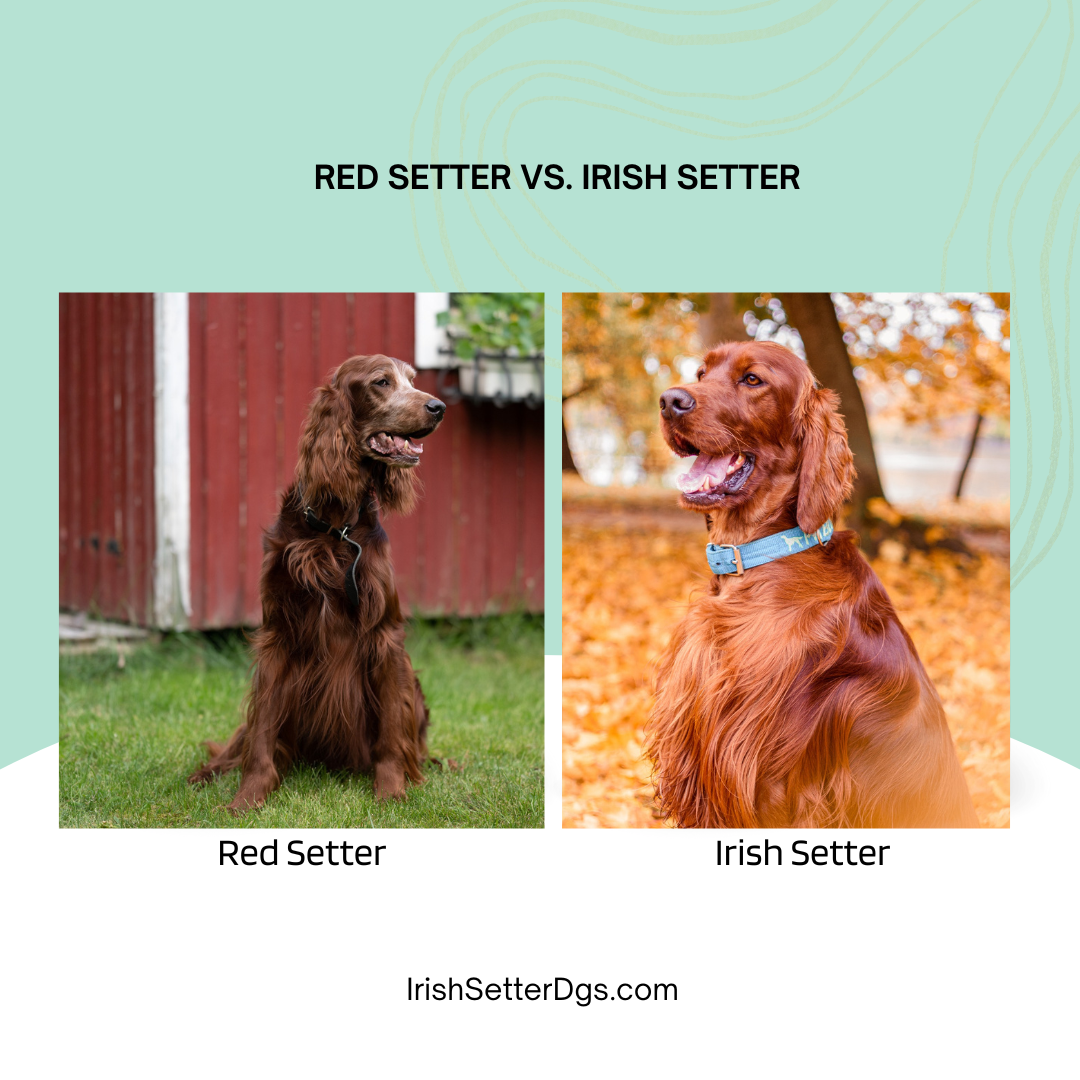Do you have a preference when it comes to Red Setters or Irish Setters? Some people are die-hard fans of one breed, but there is no right or wrong answer. In this blog post, we will compare and contrast the two breeds so that you can make an informed decision about which is best for you and your family. Both breeds are lovely dogs, but they do have their unique characteristics. So, let’s take a closer look!
Red Setter Vs. Irish Setter Breed History
The Red Setter is a relatively new breed, having been around since the early 1800s. The Red Setter is a descendant of the Irish Wolfhound and the Gordon Setter. They were initially bred in England for hunting purposes and eventually made their way to America. The Irish Setter, on the other hand, has a much longer history dating back to the 17th century. The Irish Setter is a descendant of the English setter and pointer. They were also originally bred for hunting but developed in Ireland.
Red Setter Vs. Irish Setter Physical Appearance

The most apparent difference between Irish Setters and Red Setters is their physical appearance. Let’s dig in a little deeper and compare these two breeds.
- Body Build: The Red Setter is a medium-sized dog with a strong, muscular build. The Irish Setter is also a medium-sized dog but is slightly larger than the Red Setter.
- Ears: Both breeds have long, floppy ears. However, the Red Setter’s ears are a little longer and thinner than the Irish Setter’s.
- Eyes: The Red Setter has dark, almond-shaped eyes. The Irish Setter’s eyes are a little lighter in color and are rounder in shape.
- Nose: The Red Setter has a longer, narrower nose, while the Irish Setter has a shorter, broader nose.
- Tail: The Red Setter’s tail is long and thin. The Irish Setter’s tail is shorter and thicker.
- Coat: The Red Setter has a two-layer coat that is thick and dense. The outer layer is coarse and waterproof, while the inner layer is soft and insulating. The Irish Setter’s coat has two layers like the Red Setter’s, but the inner layer is much finer.
- Color: As you might have guessed from their names, Red Setters are red all over. Irish Setters can be either red or white. However, both breeds have a lot of feathers on their legs, tails, and ears.
- Size: Red Setters are slightly larger than Irish Setters. On average, Red Setters weigh about 30-45 pounds and stand 20-24 inches tall at the shoulder. Meanwhile, Irish Setters weigh 27-40 pounds and stand 18-22 inches tall.
Red Setter Vs. Irish Setter Lifespan
The quality of care that your dog receives will have a direct impact on its lifespan. However, some breed-specific factors can also affect lifespan. Fortunately, both Irish Setters and Red Setters have relatively long lifespans. On average, Red Setters live 12-14 years while Irish Setters live 11-13 years. However, these are just averages. Some dog breeds may live much longer, while others may not make it to their expected lifespan. The best approach to guarantee your dog lives a long and happy life is to provide them with quality care, including proper nutrition, exercise, and veterinary care.
Red Setter Vs. Irish Setter Temperament
In addition to their physical appearance, Red Setters and Irish Setters have different personalities. Red Setters are known for being friendly, gentle, and good-natured. They are patient with children and get along well with other dogs. Irish Setter is also friendly but more energetic and playful than Red Setter. They are known for being clownish and silly and love playing games.
- Activity Level: Both Irish Setters and Red Setters are very active dogs. They need a lot of exercise and love to run and play. However, the Irish Setter is slightly more energetic than the Red Setter.
- Friendliness: Being friendly is a common trait in both Irish Setters and Red Setters. They love to meet new people and make friends. However, the Red Setter is a little more gentle than the Irish Setter.
- Loyalty: Loyalty means different things to different dog breeds. For some, it means being attached to their owner and following them everywhere they go. For others, it means being protective of their family and property. Red Setters are loyal in both senses of the word. The Irish Setter is also loyal but more independent than the Red Setter.
- Potential For Aggression: All dog breeds have the potential to be aggressive. Aggressiveness is usually the result of poor socialization or training. Irish Setters and Red Setters are relatively low-aggression dog breeds. However, the Irish Setter is more aggressive than the Red Setter.
Red Setter Vs. Irish Setter Adaptability

Adaptability means how well a dog can adjust to changes in its environment. Both Irish Setters and Red Setters are relatively adaptable, but the Red Setters are slightly more versatile than the Irish Setters. Red Setters are known to be calm and easygoing. They are not easily agitated and can handle change well. Irish Setter is also relatively adaptable but may be more resistant to change than Red Setter.
🐾Apartment Living
Both Red Setters and Irish Setters can live in apartments, but the Red Setter is better suited for apartment living. Red Setters are relatively quiet and can be content with smaller space. Irish Setters need more space to run and play, which may be too active for some apartments.
🐾Tolerance to Being Alone
Both Red Setters and Irish Setters need companionship and do not like to be left alone for long periods. However, the Irish Setter may be more resistant to being left alone than the Red Setter.
🐾Sensitivity
Sensitivity means how easily the Red Setter or Irish Setter is offended or bothered by things. Red Setters are relatively insensitive and are not easily offended. Irish Setter is also relatively insensitive but may be more sensitive than Red Setter. However, they are both not tolerant of harsh words or treatment.
🐾Tolerance to Cold Weather
Cold weather is not an issue for most dog breeds until it reaches freezing temperatures. However, Irish Setters and Red Setters are relatively tolerant of cold weather. It is important to provide your dog with a warm, comfortable place to stay during cold weather. Watch out for any cold-related health issues, such as frostbite or hypothermia.
🐾Tolerance to Hot Weather
Irish Setters and Red Setters are relatively tolerant of hot weather, but it’s important to practice caution. Red setters may be more resistant to heat than Irish Setters. During hot weather, it’s important to provide both breeds with enough water and cooler shade. Avoid pavements and hot surfaces that can burn their paws.
🐾Suitable for New Owners
If you consider these two breeds your first dog, Irish Setters and Red Setters are good for new owners. However, Red Setters are known to be more patient and adaptable than Irish Setters.
🐾Good With Children
If you have children at home, both Irish Setters and Red Setters are good with children. They are patient and gentle with kids. However, the Irish Setter may be more energetic and playful than the Red Setter.
🐾Good With Other Pets
If you have other pets at home, Irish Setters and Red Setters are good with other pets. They are social and enjoy the company of other animals. However, the Irish Setter may be more independent than the Red Setter.
Red Setter Vs. Irish Setter Health and Grooming Needs
Health and grooming are two crucial factors when choosing a dog breed. Both Irish Setters and Red Setters are relatively healthy breeds, but the Red Setter is known to be slightly healthier than the Irish Setter. Red Setters are relatively easy to groom. They only need to be brushed a few times a week and only require occasional baths. Irish Setters only need to be brushed a few times a week, but they may require more baths than Red Setters.
👉Amount of Shedding
Shedding is normal for Irish Setters and Red Setters. Both Red Setters and Irish Setters shed a moderate amount. However, the Irish Setter is known to shed more than the Red Setter.
👉Bathing Frequency
The bathing frequency will depend on their activity level and how much they shed. Irish Setter and Red Setter may require frequent bathing if they are active and shed a lot. The Red Setter may only require bathing a few times per year; however, the Irish Setter may require bathing every few months.
👉Drooling Possibility
Drooling is not common in either breed. Both Irish Setters and Red Setters are relatively low drooling dog breeds. However, the Irish Setter may be more likely to drool than the Red Setter.
👉Potential For Weight Gain
Weight gain is a potential health issue for both Irish Setters and Red Setters. Red Setters and Irish Setters have the potential to gain weight. However, the Red Setter is more prone to weight gain than the Irish Setter. Providing both breeds with a healthy diet and plenty of exercises is essential.
👉Health Concerns
All dog breeds have the potential to develop health problems. However, some dog breeds are more susceptible to certain health problems than others. Irish Setters and Red Setters are relatively healthy dog breeds. However, the Irish Setter is more prone to hip dysplasia than the Red Setter.
Red Setter Vs. Irish Setter Trainability
In terms of training, both Irish Setters and Red Setters are relatively easy to train. However, the Red Setter is known to be more cooperative and willing to please than the Irish Setter.
Red Setters are known for being obedient and responsive to training. They are quick learners and eager to please their owners. Irish Setter is also a quick learner, but they may be more independent and less responsive to training than Red Setter.
- Potential For Barking: Most dog breeds bark occasionally, but some breeds bark more than others. Irish Setters and Red Setters are relatively quiet dog breeds. They have the potential to bark. However, the Irish Setter is known to be a more vocal breed than the Red Setter.
- Potential For Mouthiness: Mouthiness means that a dog breed is more likely to chew on things or put its mouth on people. Irish Setters and Red Setters are relatively low mouthiness dog breeds. However, the Irish Setter is more mouthy than the Red Setter.
- Intelligence: Intelligence is the ability to learn and understand new things. Red Setters and Irish Setters are relatively intelligent dog breeds. However, the Red Setter is known to be slightly more intelligent than the Irish Setter.
- Prey Drive: Prey drive is the instinct to chase and catch prey. Red Setters and Irish Setters have a moderate prey drive. However, the Irish Setter is known to have a higher prey drive than the Red Setter.
- Potential to Wanderlust: Wanderlust is the desire to roam or travel. Red Setters and Irish Setters have a moderate wanderlust. However, the Red Setter is more prone to wanderlust than the Irish Setter.
Red Setter Vs. Irish Setter Exercise Needs
Exercise is essential for keeping the Irish Setter and Red Setter healthy and fit. Both dog breeds need moderate exercise, but the Irish Setter may need slightly more exercise than the Red Setter. Red Setters and Irish Setters are active dog breeds that enjoy being outdoors. They are suitable for people who like to go on walks or hikes. However, the Irish Setter may be more energetic and require more exercise than the Red Setter.
▸Exercise Needs by Activity Level
The amount of exercise a dog needs depends on its activity level. Red Setters and Irish Setters are relatively active dog breeds. They need moderate exercise. However, the Irish Setter may be more active and require more exercise than the Red Setter.
▸Daily Exercise Needs
Daily exercise is important for Irish Setters and Red Setters. Red Setters and Irish Setters need at least 30 minutes to 1 hour of daily physical activities. Exercise is essential for Red Setters and Irish Setters because it helps them stay fit and healthy. Furthermore, exercise can help Red Setters, and Irish Setters stay mentally stimulated.
▸Potential For Playfulness
All dog breeds have the potential to be playful. However, some dog breeds are more active than others. Red Setters and Irish Setters are relatively playful dog breeds. However, the Irish Setter is known to be more playful than the Red Setter.
Red Setter Vs. Irish Setter Diet Needs
When choosing a food for Red Setters and Irish Setters, it is important to select a food that is high in protein and fat. Red Setters and Irish Setters are active dog breeds and need a diet to help them maintain their energy levels. A high-quality dry kibble is a good option for Red Setters and Irish Setters. Make sure to choose a kibble that is suitable for active dogs. Red Setters and Irish Setters may also benefit from adding a supplement to their diet. Supplements can help active dogs maintain their energy levels and stay healthy.
- Frequency of Eating: Red Setters and Irish Setters require two to three daily feedings.
- Amount of Food Per Day: The amount of food a Red Setter or Irish Setter needs depends on size, age, and activity level.
Red Setter Vs. Irish Setter Reproducibility
Red Setters and Irish Setters are both relatively easy to reproduce. However, the Red Setter is known to be slightly easier to reproduce than the Irish Setter. When reproducing Red Setters and Irish Setters, it is important to use a reputable breeder. A reputable breeder will have healthy dogs that are well-cared for. Furthermore, a reputable breeder will be able to answer any questions you have about reproducing Red Setters and Irish Setters.
- Puppy Size: Red Setters and Irish Setters are similar in size. They are both medium-sized dog breeds. Their puppies usually weigh between 20 and 30 pounds when they are full-grown.
- Average Litter Size: The average litter size for Red Setters is six puppies. The average litter size for Irish Setters is seven puppies.
- Litter Frequency: Red Setters and Irish Setters can have multiple litters per year. However, it is recommended to space litters at least six months apart.
- Breeding Age: Red Setters and Irish Setters can start breeding at around one year old. However, it’s best to wait until they are at least two years old.
- Gestation Period: The gestation period for Red Setters and Irish Setters is nine weeks.
Frequently Asked Questions
Q: Are Red Setter or Irish Setter great guarding dogs?
No, Red Setters and Irish Setters are not great guarding dogs. They are friendly dog breeds that love to meet new people. Don’t expect them to bark or protect you from strangers unless you train them.
Q. Can an Irish Setter be cross breed with a Red Setter?
Yes, Irish Setters and Red Setters can be crossbred. It is a common practice among breeders. Cross breeding can help improve the health and temperament of both dog breeds.
When an Irish Setter crosses with a Red Setter, the puppies are usually quite healthy. They have an excellent temperament and are easy to train. Their puppies are known to be intelligent and have good memory.
Q. Which dog breed is more expensive, Red Setter or Irish Setter?
The average price of a Red Setter is $700. The average price of an Irish Setter is $800. So, the Irish Setter is slightly more expensive than the Red Setter. However, these prices are only estimates and may vary depending on the breeder, location, and other factors.
Q. Is it expensive to own a Red Setter or Irish Setter?
Yes, Red Setters and Irish Setters are both expensive to own. They are large dog breeds that require a lot of food and exercise. They also need regular vet check-ups and vaccinations. Plus, their grooming needs can be costly. Expect to spend at least $100 monthly on your Red Setter or Irish Setter.
Q. Which dog breeds are more likely to stink: Red Setter or Irish Setter?
Red Setters and Irish Setters are both large dog breeds with many furs. It means that they are more likely to stink than smaller dog breeds. They also have a lot of energy and play in the dirt. So, if you’re looking for a low-maintenance dog that doesn’t stink, Red Setters and Irish Setters are not the best choices. Instead, you might consider a smaller dog breed with fewer furs.
Q. Which of the two breeds is most likely a sailor dog: Red Setter or Irish Setter?
Sailor dog is a term used to describe a dog that is good at swimming and accompanying sailors on ships. Irish Setters are more likely to be sailor dogs than Red Setters. It is because they have strong swimming abilities and love to play in the water. They are also known to be good at following commands. So, if you’re looking for a sailor dog, Irish Setter is the better choice.
Q. How do I potty train my Red Setter or Irish Setter?
The best way to potty train your Red Setter or Irish Setter is to use positive reinforcement. It means rewarding them when they go potty in the right place. You can give them treats, praise, or petting. Avoid punishment as this can make the training process more difficult. Instead, focus on rewarding your dog for good behavior.
Final Thoughts
Red Setters and Irish Setters are both great dog breeds. When selecting a dog breed, it is critical to consider your lifestyle and personality. If you’re looking for a dog breed that is relatively active and playful, then the Irish Setter may be a good choice for you. However, if you’re looking for a dog breed that is slightly less active and more obedient, then the Red Setter may be a better choice for you.
Do you have a Red Setter or an Irish Setter? We’d love to hear about your experience in the comments below!

